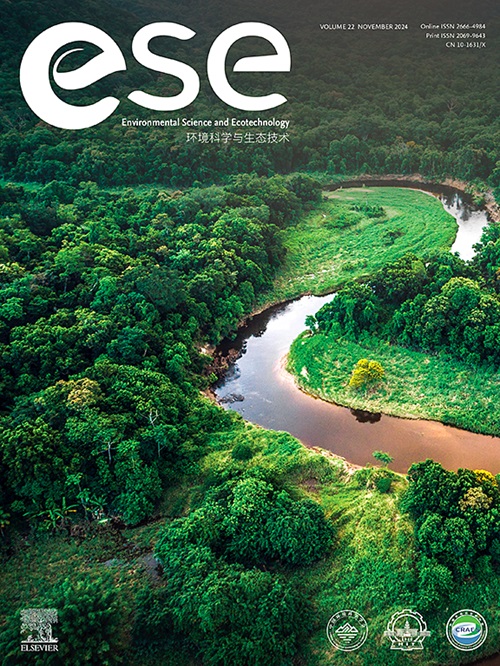Chronic toxicity mechanisms of 6PPD and 6PPD-Quinone in zebrafish
IF 14.3
1区 环境科学与生态学
Q1 ENVIRONMENTAL SCIENCES
引用次数: 0
Abstract
N-(1,3-Dimethylbutyl)-N′-phenyl-p-phenylenediamine (6PPD) and its oxidation derivative, 6PPD-quinone (6PPDQ), have been extensively detected in environmental and biological samples, raising significant concerns regarding their chronic aquatic toxicity at environmentally relevant concentrations. However, the underlying mechanisms driving this chronic toxicity remain largely unexplored. Here we show that zebrafish exposed to 6PPD and 6PPDQ exhibit distinct toxicokinetic profiles, with 6PPD preferentially accumulating in the liver and 6PPDQ predominantly targeting the brain. Exposure to both compounds impaired zebrafish growth, induced hepatic damage, and disrupted locomotor behavior. Transcriptomic analysis of liver tissue revealed disturbances in lipid and carbohydrate metabolic pathways in both treatment groups, with distinct differences in gene expression patterns and biochemical responses between 6PPD and 6PPDQ. Specifically, both compounds downregulated peroxisome proliferator-activated receptor gamma (PPARγ) and elevated the expression of pro-inflammatory cytokines (TNF-α and IL-6). Molecular dynamics simulations and surface plasmon resonance experiments further demonstrated that hepatotoxicity was associated with direct binding of these compounds to PPARγ, a critical regulator of lipid metabolism and inflammation. Our findings highlight the hepatotoxic risks of 6PPD and 6PPDQ to aquatic life. Importantly, 6PPDQ exhibited greater toxicity compared to 6PPD, emphasizing an urgent need for targeted environmental controls and regulatory actions to mitigate ecological harm and potential public health consequences.

6PPD和6PPD醌对斑马鱼的慢性毒性机制
N-(1,3-二甲基丁基)-N ' -苯基-对苯二胺(6PPD)及其氧化衍生物6PPD-醌(6PPDQ)已在环境和生物样品中广泛检测到,引起了对其在环境相关浓度下的慢性水生毒性的重大关注。然而,驱动这种慢性毒性的潜在机制在很大程度上仍未被探索。本研究表明,暴露于6PPD和6PPDQ的斑马鱼表现出不同的毒性动力学特征,6PPD优先在肝脏积累,而6PPDQ主要针对大脑。暴露于这两种化合物会损害斑马鱼的生长,引起肝损伤,并扰乱运动行为。肝脏组织转录组学分析显示,两个治疗组的脂质和碳水化合物代谢途径均出现紊乱,6PPD和6PPDQ在基因表达模式和生化反应方面存在明显差异。具体来说,这两种化合物都下调过氧化物酶体增殖物激活受体γ (PPARγ)并升高促炎细胞因子(TNF-α和IL-6)的表达。分子动力学模拟和表面等离子体共振实验进一步证明,肝毒性与这些化合物与PPARγ的直接结合有关,PPARγ是脂质代谢和炎症的关键调节因子。我们的研究结果强调了6PPD和6PPDQ对水生生物的肝毒性风险。重要的是,与6PPD相比,6PPDQ表现出更大的毒性,强调迫切需要有针对性的环境控制和监管行动,以减轻生态危害和潜在的公共卫生后果。
本文章由计算机程序翻译,如有差异,请以英文原文为准。
求助全文
约1分钟内获得全文
求助全文
来源期刊

Environmental Science and Ecotechnology
Multiple-
CiteScore
20.40
自引率
6.30%
发文量
11
审稿时长
18 days
期刊介绍:
Environmental Science & Ecotechnology (ESE) is an international, open-access journal publishing original research in environmental science, engineering, ecotechnology, and related fields. Authors publishing in ESE can immediately, permanently, and freely share their work. They have license options and retain copyright. Published by Elsevier, ESE is co-organized by the Chinese Society for Environmental Sciences, Harbin Institute of Technology, and the Chinese Research Academy of Environmental Sciences, under the supervision of the China Association for Science and Technology.
 求助内容:
求助内容: 应助结果提醒方式:
应助结果提醒方式:


